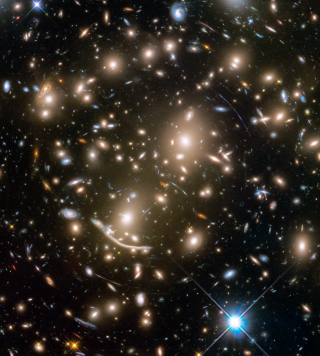Méndez-Abreu, J.; Costantin, L.; Aguerri, J. A. L.; de Lorenzo-Cáceres, A.; Corsini, E. M.
Referencia bibliográfica
Monthly Notices of the Royal Astronomical Society, Volume 479, Issue 3, p.4172-4186
Fecha de publicación:
9
2018
Número de citas
13
Número de citas referidas
13
Descripción
We present the first statistical study on the intrinsic
three-dimensional (3D) shape of a sample of 83 galactic bars extracted
from the CALIFA survey. We use the galaXYZ code to derive the bar
intrinsic shape with a statistical approach. The method uses only the
geometric information (ellipticities and position angles) of bars and
discs obtained from a multicomponent photometric decomposition of the
galaxy surface-brightness distributions. We find that bars are
predominantly prolate-triaxial ellipsoids (68 per cent), with a small
fraction of oblate-triaxial ellipsoids (32 per cent). The typical
flattening (intrinsic C/A semiaxis ratio) of the bars in our sample is
0.34, which matches well the typical intrinsic flattening of stellar
discs at these galaxy masses. We demonstrate that, for prolate-triaxial
bars, the intrinsic shape of bars depends on the galaxy Hubble type and
stellar mass (bars in massive S0 galaxies are thicker and more circular
than those in less massive spirals). The bar intrinsic shape correlates
with bulge, disc, and bar parameters. In particular with the
bulge-to-total (B/T) luminosity ratio, disc g - r colour, and central
surface brightness of the bar, confirming the tight link between bars
and their host galaxies. Combining the probability distributions of the
intrinsic shape of bulges and bars in our sample, we show that 52 per
cent (16 per cent) of bulges are thicker (flatter) than the surrounding
bar at 1σ level. We suggest that these percentages might be
representative of the fraction of classical and disc-like bulges in our
sample, respectively.
Proyectos relacionados

Evolución de Galaxias en Cúmulos
Las estructuras en el Universo, a todas las escalas de masa, se han formado de una forma jerárquica y principalmente producidas por fusiones de galaxias. Sin embargo, esta formación jerárquica de las galaxias está modulada por el entorno en el cual se crean y evolucionan. Mientras que las galaxias de campo presentan una evolución pasiva, los
Jairo
Méndez Abreu

Huellas de la Formación de las Galaxias: Poblaciones estelares, Dinámica y Morfología
Bienvenida a la página web del g rupo de investigación Traces of Galaxy Formation. Somos un grupo de investigación amplio, diverso y muy activo cuyo objetivo principal es entender la formación de galaxias en el Universo de una manera lo más completa posible. Con el estudio detellado de las poblaciones estelares como bandera, estamos constantemente
Anna
Ferré Mateu